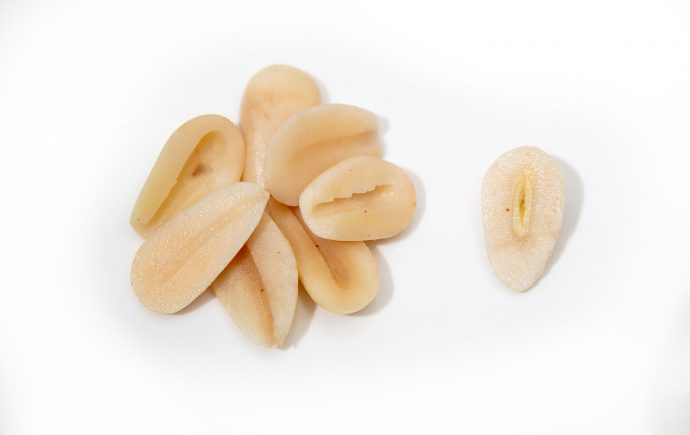Jaqueline Moura Nadolny
Jaqueline Moura Nadolny is a PhD student at The University of Queensland. Her previous qualifications include a bachelor in Chemical Engineer at UFPR (Brazil) and a MSc in Food Science and Human Nutrition from the University of Illinois at Urbana-Champaign. She received the Brazil Science Without Borders Fellowship as well as the Lemann Foundation Fellowship for her master’s degree, and BRAFAGRI Fellowship to study Food Science and Environment in France during her undergraduate studies.
Her industry experiences include oil and gas (Petrobras), pharmaceutical (Abbott Nutrition and Herbarium Laboratory) and food (ISARA Lyon). In the academic field, Jaqueline worked on enhancing the value of heirloom tomatoes by assessing their antioxidant concentration (St. Charles Horticulture Research Centre), synthesis and characterization of compounds with effect in human tumour cells (Universidade Federal do Paraná) and a few different food projects as a research assistant at the University of Queensland prior to the start of her PhD. She has also been a tutor/teacher for more than 10 years.
Her PhD is part of the Australian Research Council for Uniquely Australian Foods (ARC-UAF). The project, based in the School of Chemical Engineering, seeks to enhance the potential for developing commercially viable products for native nuts (Bunya nuts). The research includes assessing the composition and nutritional quality of Bunya nuts, investigation of different processing techniques, as well as storage stability. Her principal advisor is Professor Jason Stokes.
Projects Jaqueline Moura Nadolny is involved with:
Establishing a Value Proposition for the Bunya Nut
Read moreTitle: Advanced Processing Routes for Enhancing the Value Chain of Australian Native Nuts Overview This project focuses on compositional and nutritional quality of native Australian Bunya Nuts. The target is to assess processing techniques and..
Publications contributed to by Jaqueline Moura Nadolny:
Chemical composition of bunya nuts (Araucaria bidwillii) compared to Araucaria angustifolia and Araucaria araucana species
- Jaqueline Moura Nadolny
- Dr Gabi Netzel
- Dr Heather Shewan
- Dr Anh Phan
- A/Prof Heather Smyth
- Prof Jason Stokes
- Prof Odette Best
Visit website(2022) Chemical composition of bunya nuts (Araucaria bidwillii) compared to Araucaria angustifolia and Araucaria araucana species
Three of nineteen Araucaria tree species from around the world produce large edible seeds. While composition is established for edible pinhão and piñones nuts from Brazil and Chile, respectively, the first detailed characterisation for the composition of edible Araucaria bidwillii (bunya nut) from Australia is provided. Almost half of the kernel weight is moisture and the main component in the dried kernel is starch. Whilst low in protein and fat, it contains all essential amino acids and half the fatty acids are polyunsaturated (Omega-3 and 6). Bunya nuts are a source of dietary fibre, folate and minerals (Cu, Mn, Fe, Mg), while the nut husks and inner coating are high in phenolics, mainly catechin. The composition supports the Traditional Knowledge of Aboriginal Australians that the bunya nut is an energy dense and nutrient rich food. Similarities in the composition among the three different edible varieties were found, which should assist in developing sustainable value chain propositions via shared knowledge on processing and utilisation.
Sensory properties of Australian bunya nuts
- Jaqueline Moura Nadolny
- A/Prof Heather Smyth
- Mrs Emma Hassall
- Dr Heather Shewan
- Dr Sandra Olarte Mantilla
- Prof Jason Stokes
- Prof Odette Best
Visit website(2022) Sensory properties of Australian bunya nuts
Bunya nuts are the seeds of Araucaria bidwillii, a conifer native to South-East Queensland, Australia. They are one of the 19 species of Araucaria family found around the world, with the nuts from South America being the most commonly consumed. They are traditionally eaten boiled or roasted. This study aims to profile the sensory properties of bunya nuts with chestnut as a comparator. Since chestnuts do not come from a conifer tree, it is expected that there will be differences. Different methods of preparation are also expected to change the sensory attributes. Representative samples were collected from a variety of locations in South-East Queensland, prepared and presented to a panel of 14 experienced tasters applying conventional sensory descriptive profiling. During training, the panel developed a lexicon of 23 sensory attributes together with definitions and reference. Profiles of the boiled and roasted bunya nuts revealed higher scores for hardness on the first bite than chestnuts and, when chewed, became more crumbly, dry, and grainy. They had a savory aroma and flavor, and roasted samples exhibited a roasted aroma. Bunya nut samples were less sweet than chestnut samples. Differences in the sensory properties due to method of preparation were also observed. Boiled bunya nuts were softer and moister, with lower scores for crumbly and grainy. This research is foundational in providing technical information on the sensory profile of this important Indigenous Australian nut and provides a strong basis to support novel food sector opportunities for the bunya nut as a reemerging food source not only in Australia, but also South America. PRACTICAL APPLICATION: There is an increase demand for local, sustainable, and natural foods. Bunya nuts are native to Australia and are part of the Araucaria family, which includes 19 species that can be found around the world. To the best of our knowledge there is no study characterizing Araucaria nuts in terms of sensory attributes. This study builds a lexicon for bunya nuts and compares to chestnuts. It also shows how different preparation methods affect its sensory attributes, as well as possible future uses in product development. The outcomes might provide information to support studies on Araucaria nuts in other countries.

